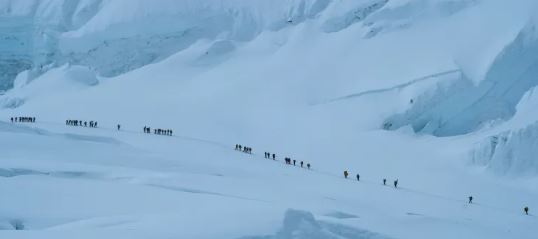A sudden blizzard on the Tibetan side of Mount Everest has stranded hundreds of trekkers and climbers at high-altitude camps and roadside pullouts, prompting a round-the-clock rescue mobilization by local authorities, volunteer teams and residents as snowdrifts blocked access routes and collapsed tents across the Everest Scenic Area. The storm hit late on Friday during China’s National Day holiday period, intensifying through Saturday and piling snow to chest height in places at elevations above 4,900 metres. By Monday, rescue coordinators said several hundred people had been escorted to lower ground while contact had been established with many more who remained pinned down by deep snow and strong winds. Tourist ticket sales and entry to the scenic area were suspended, and convoys of snowploughs and heavy machinery were sent toward the worst-hit sections as visibility improved with the passing of the core weather band.
Officials in Tingri county said hikers were being funnelled to designated meeting points for transfer to towns in the Qomolangma region, including Qudang, where makeshift shelters and hot meals were arranged inside schools and civic halls. Volunteer responders from recognized teams working in Tibet joined local villagers to knock down drifts with shovels and farm machinery where ploughs could not initially reach, while medical staff established triage areas to check for hypothermia and altitude complications among evacuees. Dozens of ambulances queued on the main approach roads as authorities kept non-essential traffic out. As of Monday afternoon, there were no official reports of fatalities linked to the blizzard on the Tibetan side, though hospitals treated multiple cases of exposure and frostbite and at least one hiker was described by local media as in serious condition after spending hours pinned in a collapsed tent.
The storm’s timing and location ensured a large footprint of stranded people. The eastern approaches to Everest are among Tibet’s most visited destinations during early October, when families, tour buses and independent trekkers pour into camps near the Rongbuk valley and onto marked trails beneath the mountain’s north face. Many of those caught out were not engaged in summit bids or technical climbing but were staying in vehicle-accessible campsites and basic lodges scattered along the approach road; others were trekking along designated routes that normally remain passable in light snow. Guides said the blizzard arrived faster and at lower elevations than forecast, with a sharp drop in temperature and winds that tore at tent seams and brought down fabric in clusters. One hiker who hurried downslope as the weather closed in told Chinese media that friends reported snow “about three feet deep” at the camps as it accumulated through the night, adding that lighter tents “were crushed”.
Rescuers said the first priority was to stabilize those most exposed and consolidate groups before attempting long evacuations through drifts that in places reached the roofs of parked minibuses. Communication lines were re-established to many stranded groups on Sunday through mountain cell towers and satellite messengers that held signal despite the weather, allowing officials to map clusters of people still waiting for extraction. Mountain rescue coordinators cautioned that the raw numbers were moving targets as people freed themselves and walked out with local help while others were located and added to the lists, but described the total caught by the storm as in the high hundreds as of late Sunday, with more than 300 brought down by early Monday and contact made with several hundred others.
